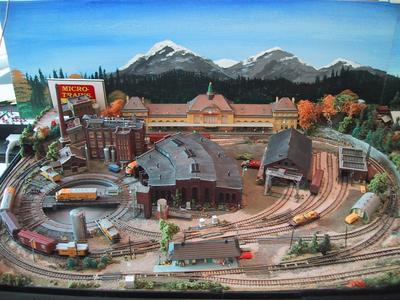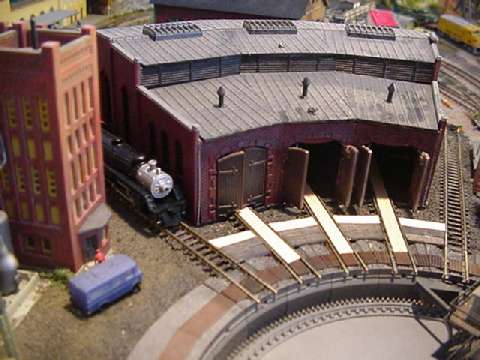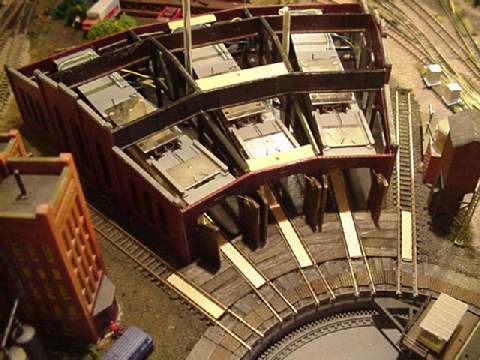The Val Ease Central Railroad ©
Taking Z Scale to the Public Around the World
(Text and photos © Copyright Jeffrey MacHan)
Last Spike: VEMRC helps lay turntable decking*

What better way to enjoy a balmy early autumn Saturday than to gather together for our annual work day at the Val Ease Central RR. This year's project put to use the talents of 6 regular, 2 probationary and 1 junior members of the VEMRC. Under the supervision of VEE shop foreman, Mark Yertimesheat, the members rolled up their sleeves and helped finish the long overdue installation of the new roundhouse and turntable apron decking.
The volunteers were divided into 3 work gangs in order to add to the general confusion!
Gang 1 was composed of our esteemed club president Willy Lastferlong, club membership chair Haywood Yacuddlemee and junior member Earnest Ahweebitt. After chosing the short straw, they had the dubious honor of hauling, dumping and leveling the gravel foundation for the decking timbers. Fortunately the VECRR supplied shovels, rakes and wheelbarrows which really helped make the work go much faster.
Gang 2, comprised of club treasurer Don Bettonnit and two recent converts to model railroading, Sam and Janet Evening, carried the precut decking timbers to their final resting places. Too bad there weren't enough gloves to go around though. Something to keep in mind for next year.
And finally, gang 3, which included Mabel Siroppe, the club railette chair, Mike Ruffone, club publicity chair and club electrician, Shortinndi Wyring, worked the tamping bars to ensure the decking had securely settled into place.
As a footnote, Mike will be out of the hospital before you know it. The good news is that there were no broken bones and the scar is hardly noticeable. For her part, Mabel swears the bar slipped, three times!
As usual, after their hard work the club members were rewarded with an invitation to the railroadmen's tavern for a brewsky where the junior and women members were unfortunately refused entry. Oh, well, at least they will fall asleep knowing that the sweet aroma of creosote will be with them for days to come.

The VEMRC volunteers are taking a well-deserved break. Work is progressing steadily with 3 rows and 3 roundhouse lead decks installed. The first two rows have been stained with a 50% india ink and rubbing alcohol mixture.

The deck is installed. All that needs to be done is stain the lead planking and round up another gang to replace the roof!
I'm sorry to say this but I think that when it comes to scenic details, we tend to get lazy. It can happen to the best of us! Sure we weather our rails and stain our ballast to simulate oil spills but we sometimes overlook the little additions to our scenes that tell a story. No, you don't have to have turntable decking. Ballast or some other material between the leads will do very adequately. But if you go to the trouble of cutting planking to fit snuggly between the rails, glue them in place with craft glue, scribe individual joints with a hobby knife and stain them with dilute india ink (there you have the entire construction story), you will have added a subtle element that not only reflects prototype practice but also shows that you have projected yourself into the scene.
That is really the key to making a scene believable to the casual observer and rewarding to you as a modeler...placing yourself in the scene along with your trains and the imaginary people who might just run them. It's not always easy to do but look at a small section of your layout and imagine yourself sitting on that fence watching the world go by. What you would likely observe, hear, smell and feel? Then try to leave the same clues in your miniature world that you would encounter in real life. The objective is to create depth, which can take us just as far as all that track we've been laying.
In our little trip back in time to fictional Val Ease with the VEMRC, I tried to envision the kind of tasks a volunteer group might actually undertake, other than the traditional "paint-the-carshed" and "plant-the-flowerbed" projects.
There's a happy ending to this story. Now that the club has lent a hand around the service yard, there's a pretty good chance the VECRR will return the favor and offer prototype tours for the next club open house and train meet coming up real soon. See you there!